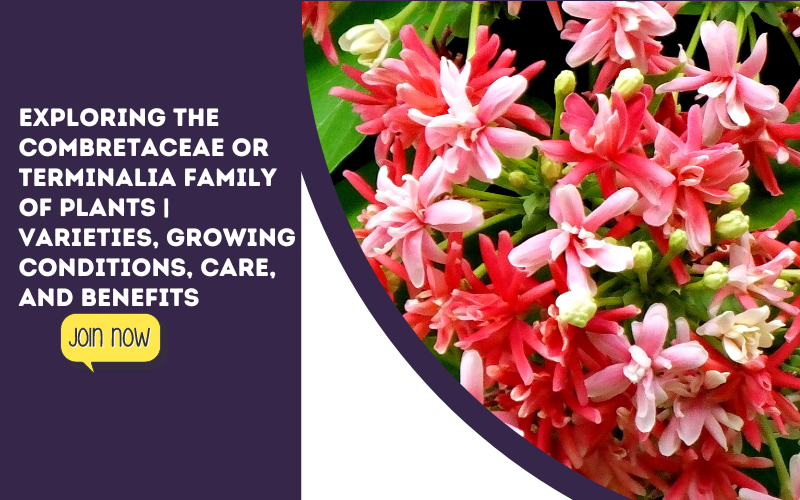
Exploring the Combretaceae or Terminalia Family of Plants | Varieties, Growing Conditions, Care, and Benefits
Introduction:
The Combretaceae family, also known as the Terminalia family, is a large and diverse group of woody plants found in tropical and subtropical regions worldwide. It is one of the most important families of trees, known for its commercial, medicinal, and ornamental uses. This family includes over 500 species of trees and shrubs, some of which are very important economically. This blog will provide a comprehensive guide to the Combretaceae or Terminalia family of plants, including information on their varieties, growing conditions, care, and benefits.
Varieties:
There are many varieties of Combretaceae plants, some of which are listed below:
-
Terminalia catappa: Also known as the Indian almond, this tree is native to Southeast Asia and the Indian subcontinent. It produces edible nuts, which are used in traditional medicine and as a food source.
-
Terminalia arjuna: This tree is native to the Indian subcontinent and is used in traditional Ayurvedic medicine to treat heart disease and other ailments.
-
Combretum indicum: Also known as the Chinese honeysuckle, this plant is native to Southeast Asia and produces beautiful orange-red flowers.
-
Combretum micranthum: This plant is native to West Africa and produces attractive yellow flowers.
-
Terminalia chebula: Also known as the black myrobalan, this tree is native to South Asia and produces a fruit that is used in Ayurvedic medicine.
-
Terminalia ferdinandiana: Also known as the Kakadu plum, this tree is native to Australia and produces a fruit that is high in vitamin C.
Growing Conditions:
Combretaceae plants are generally easy to grow and care for. They prefer warm, humid climates and well-drained soil. Most varieties of this family require full sun to thrive, although some can tolerate partial shade. In terms of temperature, these plants generally prefer temperatures between 60-90°F (15-32°C).
Care:
Here are some care tips for growing Combretaceae plants:
-
Watering: These plants require regular watering, particularly during the growing season. Water deeply once a week or when the soil feels dry to the touch.
-
Fertilization: Combretaceae plants benefit from regular fertilization. Use a balanced fertilizer during the growing season, and reduce fertilization during the winter months.
-
Pruning: Prune your plants regularly to maintain their shape and promote healthy growth. Prune in the spring or summer, and remove any dead or diseased branches.
-
Pests and diseases: Combretaceae plants are generally resistant to pests and diseases. However, they can be susceptible to root rot if they are over-watered. Keep an eye out for any signs of damage or disease, and treat as necessary.
Benefits:
The Combretaceae family of plants has many benefits, both for humans and for the environment. Here are some of the most notable benefits:
-
Medicinal uses: Many species of Combretaceae plants have medicinal properties and are used in traditional medicine to treat a variety of ailments. For example, Terminalia chebula is used in Ayurvedic medicine to treat digestive issues, while Terminalia arjuna is used to treat heart disease.
-
Commercial uses: Some species of Combretaceae plants are important economically. For example, Terminalia catappa produces nuts that are used in cooking and traditional medicine, while Terminalia ferdinandiana produces a fruit that is high in vitamin C and is used in the cosmetic industry.
-
Environmental benefits: Combretaceae plants play an important role in the environment. They provide habitat and food for wildlife, and help to stabilize soil and prevent erosion
-
Ornamental uses: Many species of Combretaceae plants are prized for their ornamental value. They produce beautiful flowers and foliage, and are often used in landscaping and as street trees.
-
Timber: Some species of Combretaceae plants produce valuable timber, which is used for construction and furniture-making. For example, Terminalia superba, also known as afara, produces a durable, attractive wood that is used in the timber industry.
-
Carbon sequestration: Combretaceae plants are important for their ability to sequester carbon. Trees and other plants absorb carbon dioxide from the atmosphere during photosynthesis, and store it in their biomass. This helps to mitigate the effects of climate change by reducing the amount of greenhouse gases in the atmosphere.
-
Traditional uses: Many cultures around the world have traditional uses for Combretaceae plants. For example, in some parts of Africa, the leaves of Combretum micranthum are used as a food wrap, while in India, Terminalia bellirica is used in Ayurvedic medicine to treat respiratory problems.
Conclusion:
The Combretaceae family of plants is a diverse and important group of woody plants found in tropical and subtropical regions worldwide. They have many benefits, including medicinal uses, commercial uses, environmental benefits, ornamental value, and traditional uses. By understanding how to grow and care for these plants, we can better appreciate their many contributions to our lives and the natural world.

Leave a comment